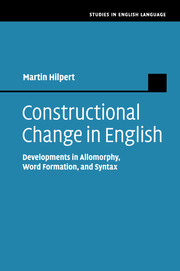Book contents
6 - Conclusions
Published online by Cambridge University Press: 05 May 2013
Summary
It was the aim of this study to come to terms with the notion of constructional change and to assess whether a constructional perspective on diachronic processes can usefully complement existing approaches to language change. Having discussed the developments of several grammatical constructions at different levels of structural organization, it is now the time to take stock of the empirical observations and to assess how the idea of constructional change can actually lead to a deeper understanding of diachronic linguistic processes. The following sections present arguments in support of this point and outline a few issues to be addressed by future research.
Constructional change and grammaticalization
A result that recurred in each of the three case studies is that many processes of change that constructions undergo fall outside the scope of what is profitably viewed as grammaticalization. In each case, some processes occur that are indeed commonly observed in grammaticalization, but at the same time, there are other processes that would not be expected.
In the development from mine to my, the gradual replacement of a form with an alternative that has less phonetic material and that spreads across more and more different contexts is fully consonant with a scenario of gram-maticalization. What is not as easily explained, however, is why two different forms, mine and thine, undergo developments that are parallel to such an extent that no behavioral differences between them can be statistically established. It is here that a constructional perspective provides helpful analytical tools. If the two forms develop in lock-step, this means that speakers have formed a generalization across both of them: both instantiate the same construction.
- Type
- Chapter
- Information
- Constructional Change in EnglishDevelopments in Allomorphy, Word Formation, and Syntax, pp. 204 - 212Publisher: Cambridge University PressPrint publication year: 2013

